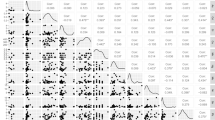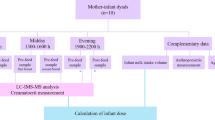Abstract
Breast milk consumption is the primary route of infant exposure to certain lipophilic toxicants that have accumulated over decades in maternal adipose tissue, as well as to less persistent toxicants from maternal exposure during lactation. Such infant exposures occur at a time of rapid growth and development when susceptibility to certain toxicants can be greatest. Breast milk and lipid intake rates are presented for the 0–6 and 0–12 month age periods for infants fed according to the American Academy of Pediatrics' current recommendations (exclusive breast-feeding for 0–6 months and continued breast-feeding to 12 months). Intake rates are normalized to infant bodyweight to account for the covariance of consumption and bodyweight. Frequency distributions describe the population variability in intake. For age 0–12 months, daily average milk intake is 100.7±22.7 g/kg day (mean±SD), with a 95th percentile of 153.5 g/kg day. Breast milk intake distributions are also developed for infants exclusively breast-fed (no significant calories from non-breast milk sources) over their first year, and for the entire (nursing and non-nursing) infant population. For short-term exposures, intake can be derived from the regression equation presented here. Lipid intake estimated assuming a 4% lipid content (current risk assessment practice) is compared and found comparable to that derived from measured lipid content. The national trend of increased breast-feeding found in surveys further supports including the breast milk pathway in risk assessment.
This is a preview of subscription content, access via your institution
Access options
Subscribe to this journal
Receive 6 print issues and online access
$259.00 per year
only $43.17 per issue
Buy this article
- Purchase on Springer Link
- Instant access to full article PDF
Prices may be subject to local taxes which are calculated during checkout

Similar content being viewed by others
References
Abbott Laboratories. Ross Laboratories Mothers Survey. Ross Products Division, Colombus, OH, 1999–2001.
Abraham K., Knoll A., Ende M., Papke O., and Helge H. Intake, fecal excretion, and body burden of polychlorinated dibenzo-p-dioxins and dibenzofurans in breast-fed and formula-fed infants. Pediatr Res 1996: 40: 671–679.
Ahn C.H., and MacLean W.C. Growth of the exclusively breast-fed infant. Am J Clin Nutr 1980: 33: 183–192.
American Academy of Pediatrics (AAP). Breastfeeding and the use of human milk. Pediatrics 1997: 100: 1035–1039.
Bitman J., Freed L.M., Neville M.C., Wood D.L., Hamosh P., and Hamosh M. Lipid composition of prepartum human mammary secretion and postpartum milk. J Pediatr Gastroenterol Nutr 1986: 5: 608–615.
Brown K.H., Black R.E., Robertson A.D., Akhtar N.A., Ahmed G., and Becker S. Clinical and field studies of human lactation: methodological considerations. Am J Clin Nutr 1982: 35: 745–756.
Brown K.H., Robertson A.D., and Akhtar N.A. Lactational capacity of marginally nourished mothers: infants' milk nutrient consumption and patterns of growth. Pediatrics 1986: 78: 920–927.
Butte N.F., Garz C., Smith E.O., and Nichols B.L. Human milk intake and growth in exclusively breast-fed infants. J Pediatr 1984: 104: 187–195.
Casey C.E., Neifert M.R., Seacat J.M., and Neville M.C. Nutrient intake by breast-fed infants during the first five days after birth. Am J Dis Child 1986: 140: 933–936.
Dewey K.G., Finley D.A., and Lonnerdal B. Breast milk volume and composition during late lactation (7–20 months). J Pediatr Gastroenterol Nutr 1984: 3: 713–720.
Dewey K.G., Heinig M.J., Nommsen L.A., and Lonnerdal B. Adequacy of energy intake among breast-fed infants in the DARLING study: relationships to growth velocity, morbidity, and activity levels. J Pediatr 1991a: 119: 538–547.
Dewey K.G., Heinig M.J., Nommsen L.A., and Lonnerdal B. Maternal versus infant factors related to breast milk intake and residual milk volume: the DARLING study. Pediatrics 1991b: 87: 829–837.
Dewey K.G., and Lonnerdal B. Milk and nutrient intake of breast-fed infants from 1 to 6 months: relation to growth and fatness. J Pediatr Gastroenterol Nutr 1983: 3: 497–506.
Drew R.T., Boorman G.A., Haseman J.K., McConnell E.E., Busy W.M., and Moore J.A. The effect of age and exposure duration on cancer induction by a known carcinogen in rats, mice and hamsters. Toxicol Appl Pharmacol 1983: 68: 120–130.
Ferris A.M., Neubauer S.H., Bendel R.B., Green K.W., Ingardia C.J., and Reece E.A. Perinatal lactation protocol and outcome in mothers with and without insulin-dependent diabetes mellitus. Am J Clin Nutr 1993: 58: 43–48.
Fomon S.J. Nutrition of Normal Infants. Mosby, St. Louis, MO, 1993.
Garza C., Johnson C.A., Smith E.O., and Nichols B.L. Changes in the nutrient composition of human milk during gradual weaning. Am J Clin Nutr 1983: 37: 61–65.
Hofvander Y., Hagman U., Hillervik C., and Sjolin S. The amount of milk consumed by 1–3 months old breast- or bottle-fed infants. Acta Paediatr Scand 1982: 71: 953–958.
Hoover S., Zeise L., and Krowech G. Exposure to environmental contaminants through breast milk. Adv Risk Anal 1991: 9: 257–266.
Jackson M.B., Lammi-Keefe C.J., Jensen R.G., Couch S.C., and Ferris A.M. Total lipid and fatty acid composition of milk from women with and without insulin-dependent diabetes mellitus. Am J Clin Nutr 1994: 60: 353–361.
Lowenfeld M.F., Widdows S.T., and Gregory H.H.C. Percentage of fat in human milk. Lancet 1934, May 2: 1003–1004.
Martinez G.A., and Dodd D.A. Milk feeding patterns in the United States during the first 12 months of life. Pediatrics 1983: 71: 166–170.
Martinez G.A., Dodd D.A., and Samartgedes J.A. Milk feeding patterns in the United States during the first 12 months of life. Pediatrics 1981: 68: 863–868.
Matheny R., and Picciano M.F. Feeding and growth characteristics of human milk-fed infants. J Am Diet Assoc 1986: 86: 327–331.
Maxwell N.I., and Burmaster D.E. A simulation model to estimate a distribution of lipid intake from breast milk during the first year of life. J Exp Anal Environ Epidemiol 1993: 3: 383–406.
McClelland D.B., McGrath J., and Samson R.R. Antimicrobial factors in human milk: studies of concentration and transfer to the infant during the early stages of lactation. Acta Paediatr Scand Suppl 1978: 271: 1–20.
National Research Council (NRC). The Effects on Populations of Exposure to Low Levels of Ionizing Radiation. National Academy Press, Washington, DC, 1980.
Naylor A.J. Baby-Friendly Hospital Initiative: protecting, promoting, and supporting breastfeeding in the twenty-first century. Pediatr Clin North Am 2001: 48: 475–483.
Neubauer S.H., Ferris A.M., Chase C.G., Fanelli J., Thompson C.A., Lammi-Keefe C.J., Clark R.M., Jensen R.G., Bendel R.B., and Green K.W. Delayed lactogenesis in women with insulin-dependent diabetes mellitus. Am J Clin Nutr 1993: 58: 54–60.
Neville M.C., Allen J.C., Archer P.C., Casey C.E., Seacat J., Keller R.P., Lutes V., Rasbach J., and Neifert M. Studies in human lactation: milk volume and nutrient composition during weaning and lactogenesis. Am J Clin Nutr 1991: 54: 81–92.
Neville M.C., Keller R., Seacat J., Lutes V., Neifert M., Casey C., Allen J., and Archer P. Studies in human lactation: milk volumes in lactating women during the onset of lactation and full lactation. Am J Clin Nutr 1988: 48: 1375–1386.
Nommsen L.A., Lovelady C.A., Heinig M.J., Lonnerdal B., and Dewey K.G. Determinants of energy, protein, lipid, and lactose concentrations in human milk during the first 12 months of lactation: The DARLING study. Am J Clin Nutr 1991: 53: 457–465.
Office of Environmental Health Hazard Assessment (OEHHA). Air Toxics “Hot Spots” Program Risk Assessment Guidelines. IV: Technical Support Document for Exposure Assessment and Stochastic Analysis. California Environmental Protection Agency, Sacramento, CA, 2000.
Patandin S., Dagnelie P.C., Mulder P.G., Op de Coul E., van der Veen J.E., Weisglas-Kuperus N., and Sauer P.J. Dietary exposure to polychlorinated biphenyls and dioxins from infancy until adulthood: a comparison between breast-feeding, toddler, and long-term exposure. Environ Health Perspect 1999: 107: 45–51.
Patton S., and Huston G.E. Membrane distribution and carotenoid content in human colostrum. J Pediatr Gastroenterol and Nutr 1986: 5: 774–779.
Peto R., Gray R., Brantom P., and Grasso P. Nitrosamine carcinogenesis in 5120 rodents. IARC Scientific Publication 1984: 57: 627–665.
Prentice A.M., Lucas A., Vasquez-Velasquez L., Davies P.S., and Whitehead R.G. Are current dietary guidelines for young children a prescription for overfeeding? Lancet 1988: 2 (8619): 1066–1069.
Ryan A.S. The resurgence of breastfeeding in the United States. Pediatrics 1997: 99: e12.
Ryan A.S., Pratt W.F., Wyson J.L., Lewandowski G., McNally J.W., and Krieger F.W. A comparison of breast-feeding data from the National Surveys of Family Growth and the Ross Laboratories Mothers Surveys. Am J Public Health 1991: 81: 1049–1052.
Ryan A.S., Wenjun Z., and Acosta A. Breastfeeding continues to increase in the new millennium. Pediatrics 2002: 110: 1103–1109.
Sachter D.S. DHHS blueprint for action on breastfeeding. Public Health Rep 2001: 116: 72–73.
Saint L., Smith M., and Hartmann P.E. The yield and nutrient content of colostrum and milk of women from giving birth to one-month post-partum. Br J Nutr 1984: 52: 87–95.
Salmenpera L., Perheentupa J., and Siimes M.A. Exclusively breast-fed healthy infants grow slower than reference infants. Pediatr Res 1985: 19: 307–312.
Schecter A., Papke O., Lis A., Ball M., Ryan J.J., Olson J., Li L., and Kesler H. Decrease in milk and blood dioxin levels over two years in a mother nursing twins: estimates of decreased maternal and increased infant dioxin body burden from nursing. Chemosphere 1996: 32: 543–549.
Schreiber J., Hudnell K., Parker J., and Kaminsky L. Assessing residential exposure to tetrachloroethene using biomarkers and visual system testing in populations living above dry cleaning facilities [abstract]. The Toxicol 1998: 42: 132.
Smith A.H. Infant exposure assessment for breast milk dioxins and furans derived from incineration emissions. Risk Anal 1987: 7: 347–353.
Sonawane B.R. Chemical contaminants in human milk: an overview. Environ Health Perspect 103 Suppl 1995: 6: 197–205.
Stuff J.E., and Nichols B.L. Nutrient intake and growth performance of older infants fed human milk. J Pediatr 1989: 115: 959–968.
Sugarman M., and Kendall-Tackett K.A. Weaning ages in a sample of American women who practice extended breastfeeding. Clin Pediatr 1995: 34: 642–649.
Tabachnick B.G., and Fidell L.S. Using Multivariate Statistics, 3rd ed. Harper Collins College Publishers, Inc., New York, NY, 1996.
U.S. Department of Health and Human Services (U.S. DHHS). Healthy People: Understanding and Improving Health, 2nd ed. Public Health Service, Washington, DC, 2000.
U.S. Environmental Protection Agency (U.S. EPA). Exposure Factors Handbook. EPA/600/P-95/002Fb. National Center for Environmental Assessment, Washington, DC, 1997.
Visness C.M., and Kennedy K.I. Maternal employment and breast-feeding: findings from the 1988 National Maternal and Infant Health Survey. Am J Public Health 1997: 87: 945–950.
Whitehead R.G., and Paul A.A. Infant growth and human milk requirements: a fresh approach. Lancet 1981: 2: 161–163.
Woolridge M.W., Butte N., Dewey K.G., Ferris A.M., Garza C., and Keller R.P. Methods for the measurement of milk volume intake of the breast-fed infant. In: Jensen RG, Neville MC (Eds.) Human Lactation: Milk Components and Methodologies. Plenum, New York, 1985, pp. 5–21.
Wright A., Rice S., and Wells S. Changing hospital practices to increase the duration of breastfeeding. Pediatrics 1996: 97: 669–675.
Acknowledgements
We gratefully acknowledge K. Dewey, A. Ferris L. Salmenpera, and J. Stuff for providing datasets with individual infant data.
Author information
Authors and Affiliations
Corresponding author
Rights and permissions
About this article
Cite this article
Arcus-Arth, A., Krowech, G. & Zeise, L. Breast milk and lipid intake distributions for assessing cumulative exposure and risk. J Expo Sci Environ Epidemiol 15, 357–365 (2005). https://doi.org/10.1038/sj.jea.7500412
Received:
Accepted:
Published:
Issue Date:
DOI: https://doi.org/10.1038/sj.jea.7500412
Keywords
This article is cited by
-
The impact of the 2019/2020 Australian landscape fires on infant feeding and contaminants in breast milk in women with asthma
International Breastfeeding Journal (2023)
-
Estimated postnatal p,p’-DDT and p,p’-DDE levels and body mass index at 42 months of age in a longitudinal study of Japanese children
Environmental Health (2020)
-
Interpreting PCB levels in breast milk using a physiologically based pharmacokinetic model to reconstruct the dynamic exposure of Italian women
Journal of Exposure Science & Environmental Epidemiology (2012)



